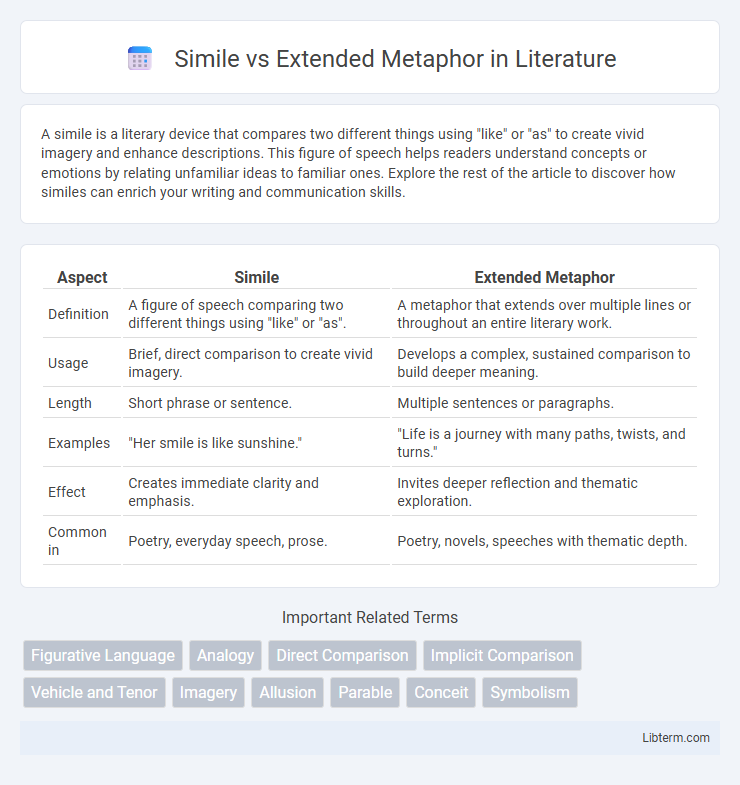A simile is a literary device that compares two different things using "like" or "as" to create vivid imagery and enhance descriptions. This figure of speech helps readers understand concepts or emotions by relating unfamiliar ideas to familiar ones. Explore the rest of the article to discover how similes can enrich your writing and communication skills.
Table of Comparison
| Aspect | Simile | Extended Metaphor |
|---|---|---|
| Definition | A figure of speech comparing two different things using "like" or "as". | A metaphor that extends over multiple lines or throughout an entire literary work. |
| Usage | Brief, direct comparison to create vivid imagery. | Develops a complex, sustained comparison to build deeper meaning. |
| Length | Short phrase or sentence. | Multiple sentences or paragraphs. |
| Examples | "Her smile is like sunshine." | "Life is a journey with many paths, twists, and turns." |
| Effect | Creates immediate clarity and emphasis. | Invites deeper reflection and thematic exploration. |
| Common in | Poetry, everyday speech, prose. | Poetry, novels, speeches with thematic depth. |
Introduction to Figurative Language
Similes use "like" or "as" to directly compare two different things, creating vivid imagery in figurative language. Extended metaphors develop a single metaphor throughout a passage, offering deeper and more complex layers of meaning. Both techniques enrich literary expression by enhancing descriptions and evoking stronger emotional responses.
Defining Simile: Meaning and Purpose
A simile is a figure of speech that directly compares two different things using "like" or "as" to highlight similarities, making descriptions more vivid and relatable. Its primary purpose is to create clear, imaginative imagery that helps readers quickly grasp complex ideas or emotions by drawing familiar parallels. Unlike an extended metaphor, which develops a comparison throughout a longer passage, a simile offers a concise and focused comparison within a single phrase or sentence.
Understanding Extended Metaphor
Extended metaphor deepens meaning by developing a single metaphor throughout a text, allowing complex ideas to be explored with greater nuance. Unlike a simile, which uses "like" or "as" for direct comparison, an extended metaphor integrates multiple layers and elaborates on the initial analogy. This technique enhances thematic depth and emotional resonance by consistently reinforcing the central metaphorical concept.
Key Differences Between Simile and Extended Metaphor
Similes use "like" or "as" to make direct comparisons between two unlike things, creating vivid imagery in a concise form. Extended metaphors develop a single metaphorical idea throughout an entire poem, paragraph, or passage, providing a more complex and sustained comparison. Key differences include the brevity and clarity of similes versus the depth and elaboration found in extended metaphors.
Structure and Language of Similes
Similes use explicit comparative language such as "like" or "as" to directly link two distinct entities, creating clear and concise imagery. Their structure often follows a straightforward pattern, typically "A is like B," which facilitates immediate understanding through vivid sensory or emotional associations. Language in similes tends to be simple and accessible, leveraging familiar comparisons to enhance relatability and impact within poetic or prose contexts.
Crafting Effective Extended Metaphors
Crafting effective extended metaphors involves developing a single metaphorical concept throughout a passage or entire work to create deeper resonance and layered meaning. Unlike similes, which make brief, direct comparisons using "like" or "as," extended metaphors require consistent imagery and detailed exploration of the metaphor's components to engage the reader's imagination fully. Mastery of extended metaphors enhances thematic complexity and emotional impact, enriching literary and rhetorical works.
Examples of Simile in Literature
Similes in literature vividly compare two unlike things using "like" or "as," enhancing imagery and emotional impact, such as in Shakespeare's "As merry as the day is long" from *Much Ado About Nothing*. Another classic example appears in Robert Burns' *A Red, Red Rose*, where love is described "like a red, red rose," emphasizing beauty and passion. These explicit comparisons contrast with extended metaphors, which develop a single metaphorical concept throughout a passage or entire work, creating deeper symbolic meaning.
Notable Extended Metaphors in Classic Works
Notable extended metaphors in classic literature, such as Shakespeare's comparison of life to a stage in "As You Like It," reveal complex layers of meaning that develop throughout entire passages or scenes. Unlike similes, which use "like" or "as" for concise comparisons, extended metaphors sustain a single metaphorical idea to deepen thematic exploration, as seen in Emily Dickinson's "Because I Could Not Stop for Death," where death is personified and explored extensively. These rich, continuous metaphorical frameworks enrich narrative depth and invite readers to engage with abstract concepts on a profound level.
When to Use Simile vs Extended Metaphor
Similes effectively highlight specific comparisons using "like" or "as," making them ideal for concise, vivid imagery that clarifies a point quickly. Extended metaphors develop a single metaphorical idea throughout a longer passage, allowing for deeper exploration of complex themes and richer emotional resonance. Choose similes for brief, impactful descriptions and extended metaphors when you want to create a sustained, layered narrative or argument.
Enhancing Writing with Figurative Comparisons
Similes use "like" or "as" to draw direct comparisons, making descriptions clear and relatable, while extended metaphors develop a single comparison throughout a passage, creating deeper symbolism and cohesion. Utilizing similes enhances writing by providing immediate imagery that helps readers quickly grasp concepts, whereas extended metaphors enrich narratives by elaborating themes and emotions with layered meaning. Mastering both devices allows writers to craft vivid, engaging prose that resonates on multiple levels.
Simile Infographic

 libterm.com
libterm.com